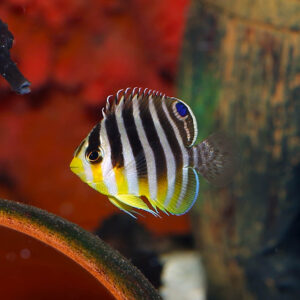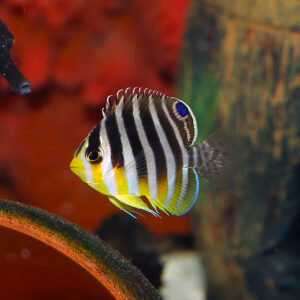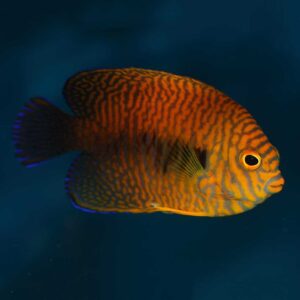Mystery Wrasse, Pseudocheilinus ocellatus, also go by the name White Barred Wrasse. Like all members of the Pseudocheilinus genus, males and females look alike. However, other wrasse species display sexual dimorphism.
These fish are active and charismatic. Mystery Wrasse have gorgeous purple bodies and bright yellow heads. Pink scribbles adorn their face and they sport a dark eye spot on their tail. Their fins are translucent with hues of: pink, purple and yellow. As the fish gets older, their colours get more pronounced.
Pseudocheilinus live in the tropics. This genus is small when compared to other wrasse species.
Mystery Wrasse, Pseudocheilinus ocellatus, Ecology.
Mystery Wrasse live in the Pacific Ocean, around the Marshall Islands. They live on rich coral reefs and as the name suggests, they are hard to track. They keep to themselves in the darker areas on the reef.
The complex structures help the wrasse avoid predation. Unlike some species, Mystery Wrasse do not bury themselves to sleep or hide. Instead they have a nifty trick. In order to sleep safely, Mystery Wrasse find a nook and envelope themselves in a protective mucus coat. Supposedly, this hides the wrasses scent from predators. These sticky invisibility cloaks do not degrade your water quality like some coral wax jackets’ might.
Mystery Wrasse feed on small benthic inverts. They have been known to eat pest species in captivity, such as flat worms and pyramidellid snails. We recommend consulting a member of staff if pest control is what you are after.
They are also protogynous hermaphrodites. Which means that, when they get old enough, breeding females turn into a male. As a result, all juveniles are immature females.
White Barred Wrasse: In The Aquarium.
It is important to mimic the natural environment by providing plenty of nooks and crannies for the wrasse to hide in. Hobbyists should invest in a jump guard to prevent any unlucky mishaps.
Mystery Wrasse do best when fed a varied diet. They will accept enriched frozen mysis shrimp and enriched frozen brine shrimp. They will also devour live foods, such as copepods and amphipods, that can be cultivated in attached refugium. Over time they will accept high-quality pellet or flake. We adapt all our wrasse to aquarium life before they leave us. We focus on their health, and most are eating a good quality flake food and/or pellet, such as JBL Maris, before being offered for sale.





Reviews
There are no reviews yet.